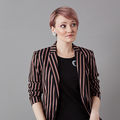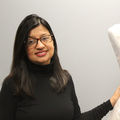Interviews
'Body scanner' the future of Baylor fashion students
02 Sep '11
4 min read
By merely stepping into a darkened booth, gripping a couple of handles and pushing a "trigger" with your thumb, you one day may be able to virtually try on garments and find the perfect fit -- all without a glance in a mirror or a second opinion from a shopping companion.
The procedure, which uses a body scanner, is a high-tech alternative to the time-consuming and often frustrating process of finding clothes that emphasize one's best body features and minimize flaws. A body scanner is the future of fashion, and students and faculty in Baylor University's family and consumer sciences department are getting a head start, said Dr. Rinn Cloud, the Mary Gibbs Jones Endowed Chair in Textiles at Baylor.
"It's a sophisticated work in progress, and retail applications are in the early stage, but there are all kinds of possibilities, among them design of posture-improving clothes or protective clothing for those in the medical field," she said.
"The issues in the medical field are fit, comfort, mobility and how quickly you can get the protective garment on and off," said Cloud, who is researching design of surgical and isolation gowns. "If you're a nurse treating a bleeding patient, but the fluid-resistant gown is preventing your movements, there's more of a chance you won't wear it."
Baylor's $35,000 scanner and software work this way: You step into a curtained dressing room for privacy, don form-fitting clothes such as bike shorts and a tank top or sports bra, then step into an octagonal chamber, complete with piped-in music.
Plant your feet on the markers, hold your arms out to the side to clasp handles and push a button. White lights flash and 32 cameras capture a 360-degree image with hundreds of measurements -- all in less than 30 seconds.
Once you emerge from the booth, a high-resolution, three-dimensional body shape is displayed on a computer screen. With a little clicking and dragging of the computer's mouse, the avatar-like image can be rotated, enlarged, panned and tilted forward and backward, and virtual clothing can be wrapped around the body.
Right now, the pre-loaded wardrobe for "Adam" and "Eva" is basic, with such options as a black jacket, blue sweater or white shirt for men and a few styles of dresses or pantsuits for women.
Hair color or style and skin tone can be added using personal photos or by selecting from a menu. Choices include a few dozen hair types and styles ranging from bobs, long waves and crew cuts to thinning hair, pigtails and dreadlocks.
The body scan data is compatible for use with software programs designed to customize avatars, including some being developed by retailers for virtual dressing rooms. As apparel designers, manufacturers and retailers blend technology into their work, options will multiply.
With the scanner providing cross sections, surface areas and "slices" of the body, consumers can provide detailed body information that allows design and production of tailor-made clothes at reasonable prices. Ready-to-wear clothes also will be improved as nationwide data bases of 3D scan information will allow apparel developers to accommodate such traits as short waists or wide hips.
The procedure, which uses a body scanner, is a high-tech alternative to the time-consuming and often frustrating process of finding clothes that emphasize one's best body features and minimize flaws. A body scanner is the future of fashion, and students and faculty in Baylor University's family and consumer sciences department are getting a head start, said Dr. Rinn Cloud, the Mary Gibbs Jones Endowed Chair in Textiles at Baylor.
"It's a sophisticated work in progress, and retail applications are in the early stage, but there are all kinds of possibilities, among them design of posture-improving clothes or protective clothing for those in the medical field," she said.
"The issues in the medical field are fit, comfort, mobility and how quickly you can get the protective garment on and off," said Cloud, who is researching design of surgical and isolation gowns. "If you're a nurse treating a bleeding patient, but the fluid-resistant gown is preventing your movements, there's more of a chance you won't wear it."
Baylor's $35,000 scanner and software work this way: You step into a curtained dressing room for privacy, don form-fitting clothes such as bike shorts and a tank top or sports bra, then step into an octagonal chamber, complete with piped-in music.
Plant your feet on the markers, hold your arms out to the side to clasp handles and push a button. White lights flash and 32 cameras capture a 360-degree image with hundreds of measurements -- all in less than 30 seconds.
Once you emerge from the booth, a high-resolution, three-dimensional body shape is displayed on a computer screen. With a little clicking and dragging of the computer's mouse, the avatar-like image can be rotated, enlarged, panned and tilted forward and backward, and virtual clothing can be wrapped around the body.
Right now, the pre-loaded wardrobe for "Adam" and "Eva" is basic, with such options as a black jacket, blue sweater or white shirt for men and a few styles of dresses or pantsuits for women.
Hair color or style and skin tone can be added using personal photos or by selecting from a menu. Choices include a few dozen hair types and styles ranging from bobs, long waves and crew cuts to thinning hair, pigtails and dreadlocks.
The body scan data is compatible for use with software programs designed to customize avatars, including some being developed by retailers for virtual dressing rooms. As apparel designers, manufacturers and retailers blend technology into their work, options will multiply.
With the scanner providing cross sections, surface areas and "slices" of the body, consumers can provide detailed body information that allows design and production of tailor-made clothes at reasonable prices. Ready-to-wear clothes also will be improved as nationwide data bases of 3D scan information will allow apparel developers to accommodate such traits as short waists or wide hips.
Popular News
Leave your Comments
Editor’s Pick
Yohan Lawrence
Joint Apparel Association Forum (JAAFSL)
Andreas Rass
ZIMMER AUSTRIA | Digital Printing Systems
































-Ltd..jpg?tr=w-120,h-60,c-at_max,cm-pad_resize,bg-ffffff)





.jpg?tr=w-120,h-60,c-at_max,cm-pad_resize,bg-ffffff)
.jpg?tr=w-120,h-60,c-at_max,cm-pad_resize,bg-ffffff)






